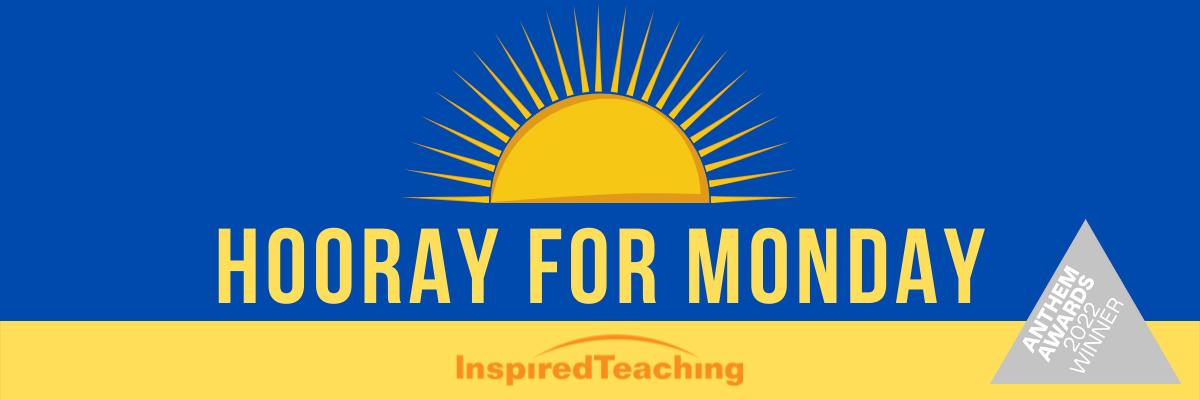May 23, 2022
By Aleta Margolis, Founder and President, Center for Inspired Teaching
Hooray for Monday is a weekly blog filled with questions, ideas, reflections, and actions we can all take to remodel the school experience for students.

Listen to this issue below the Resource section or on SoundCloud!
In The Book of Delights, poet and author Ross Gay coins the phrase “cognitive athleticism” which, he explains, is “figuring something out, which is something we all go to school, some of us for years and years, to forget how to do.”

I love Ross Gay for many reasons; but when I read those words (actually I heard them, since I am experiencing The Book of Delights via audiobook), I knew him to be a kindred spirit. Ross Gay’s words challenge teachers and parents to face the question: Could our efforts to help our kids be getting in the way of their learning?
As educators, we understand the importance of allowing students to engage in productive struggle – an important component of Purpose, Persistence, and Action, one of Inspired Teaching’s Core Elements. We do our best to find opportunities to step back and offer students the space to figure things out on their own. But the pressures of school can compel us to step in and offer a “proven” strategy for solving a challenging math problem, or structuring a paragraph, or inserting ourselves into an argument between friends, instead of allowing students to figure these things out for themselves.
Parents feel this pressure too. As a recent front-page Washington Post article pointed out, many young children arrived at school this year (after a year of at-home learning, thanks to the pandemic) lacking basic skills such as the ability to tie their shoes, open a juice box, or even turn the pages of a book. For parents who spent a school year and then some with their kids learning on a screen in the kitchen while they worked their own jobs across the table, fixing things for kids was a reasonable and expedient thing to do. It’s far more efficient to tie kids’ shoes when it’s time to head outside, turn the pages of the book during bedtime reading, and open juice boxes carefully instead of risking purple stains on the carpet.

During this extremely challenging year when mental health issues in young people are at an all-time high, it can seem counterintuitive to step back when kids are struggling. Yet, the experience of puzzling through a low-stakes problem (and yes, math problems are low-stakes problems) and arriving at a solution on your own builds self-confidence and resilience.
If we want to set our sights on building “cognitive athleticism” in young people (and I highly recommend we do so!), then we need to entrust children to be in charge of their own learning. And that means allowing them to figure things out for themselves and avoiding solving problems kids can solve. Below you will find some suggestions for where to begin.
As the child psychologist Jean Piaget said, “Every time we teach a child something, we keep him from inventing it himself.” Though it takes time and patience, allowing our children to struggle and learn for themselves will help them build the self-confidence and resilience that will serve them well in school, at home, and in all aspects of life. The past two years have shown us that this kind of resilience is essential in navigating the unknown, and our children deserve every opportunity to cultivate these problem-solving skills when the stakes are low so they will know how to employ them in the world beyond our care.
Resources
3 Ways to Bolster “Cognitive Athleticism”

- Offer feedback and encouragement to young people as they learn. “What can I do to help you get started?” “What can I do to help you finish?” “I can see how quickly you solved that problem.” “I can see you’re taking your time with that problem.” Words like these, which my mentor Judy White taught me, show our children we support them, and trust them to figure out how to tie their own shoes, turn their own pages, open their own juice boxes, and navigate any other problems they may encounter.
- Help our children and ourselves to “right-size” problems and learn to differentiate between those that require parental intervention or support (cleaning up broken glass off the kitchen floor) and those that are ripe for productive struggle (figuring out how to open a snack bag). Is this a problem about safety, or does it involve pushing through frustration into learning? When a problem is challenging due to difficulty and frustration, one strategy that works well with children is to ask them, “If you had to put this problem in a box, show me with your arms how big the box would need to be.” That mental translation of our feelings of frustration into something tangible can offer a useful pause for reflection and help us as adults to adjust our response in equal proportion.
- Start a conversation with the parents in your school community. Share this post with them and begin a discussion. Brainstorm a list of things to stop doing and a list of things to start doing in school and at home in order to support students’ ability to figure things out for themselves.
